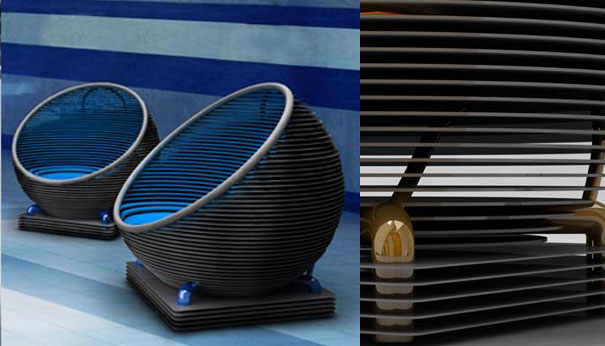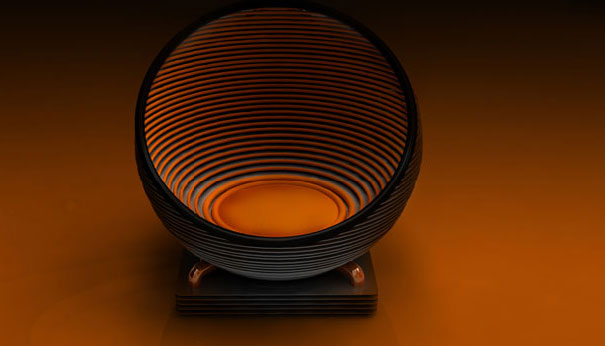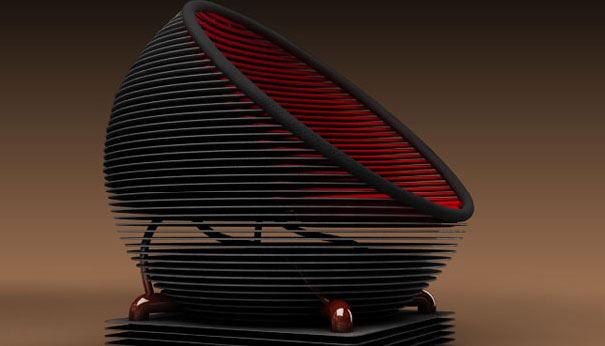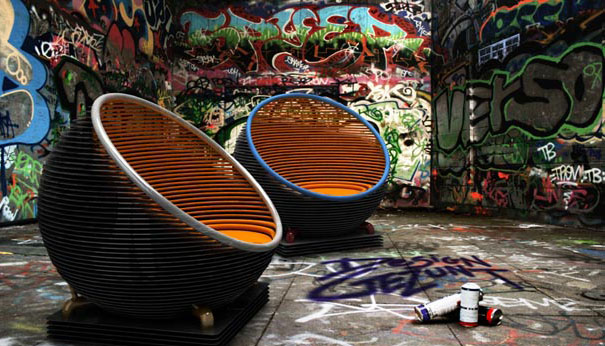Hi-Tech Couch by Design Gezunt
The mise-en-scene on Design Gezunt’s website gives more than a clue or two regarding their driving philosophy: a modern incarnation of one of those desktop “entropy ball” devices dominates the foreground of a room whose white brick walls and oddly-amorphous chairs can only be described as “retro-futuresque.” With the studio’s name etched on the wall astride a smaller placard proclaiming, “since 2020,” the aesthetic is one of a scientific sensibility fused with a witty historical outlook.
Hi-Tech Couch. Designed by Design Gezunt
Design Gezunt demonstrates drive to “create and design every idea… to stretch the borders of what’s possible,” even if, one concurs, this includes bending the laws of thermodynamics or disrupting the space-time continuum. Or perhaps it just foretells of a collective eye that’s hyper-alert to the great potential of the ostensibly mundane stuff that surrounds us, as demonstrated in Jenny’s post two weeks back (screws and nails become “Bo-Lighting”) and in today’s Hi-Tech Couch.
If you too have a sense of the historical, the first attribute of Hi-Tech you’ll notice is its overt debt to Eero Aarnio’s Ball and Bubble Chairs, not to mention Henrik Thor-Larsen’s classic Ovalia Egg Chair. The similarities here are manifest. However, and much in the manner of all good parodists, Hi-Tech carves out a space all its own—the silhouette, though reminiscent of the aforementioned iconic pieces, is ultimately one of a kind, its aperture arching skyward, quite different from the forward-oriented openings of both “Egg” And “Bubble,” and somehow reminding me of the expectant mouth of some giant future (or prehistoric), and quite hungry, hatchling.




The second thing you’ll notice is that contrary to all logic of naming, DG has decided to call the piece the “Hi-Tech Couch” (or “Hi-Tech Sofa”) rather than the more precise “Hi-Tech Chair,” though this confusion is instantly dispelled by the helpful and clarificatory subheading: “a sofa for one.” All carping and silliness re: naming aside, the stand-out feature of Hi-Tech is its centrifugal-style construction, modeled on the cooling ribs of computers: “built by layers of deferent material boards, from aluminum or recycled materials like pounded industrial plastic, [the coils] disperse the hit energy with the special structure of the sofa.”
Not that a reclining habitué of the Hi-Tech would necessarily bring much “Hit Energy” to bear on the piece’s structural integrity, but to the extent we somehow absorb all that virtual hunting and gathering we do every day—and therefore need a receptacle for it, lest we become filled to the brim with the Internet’s detritus—this particular furnishing certainly fills the bill. It looks like the future and the past at once, and it promises a singularly contemporary brand of rest and rejuvenation.




Leave a Reply